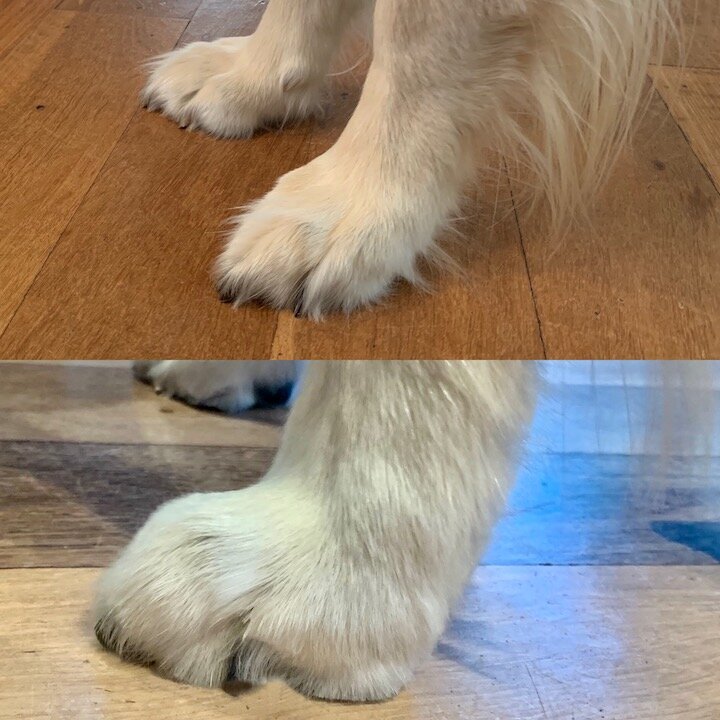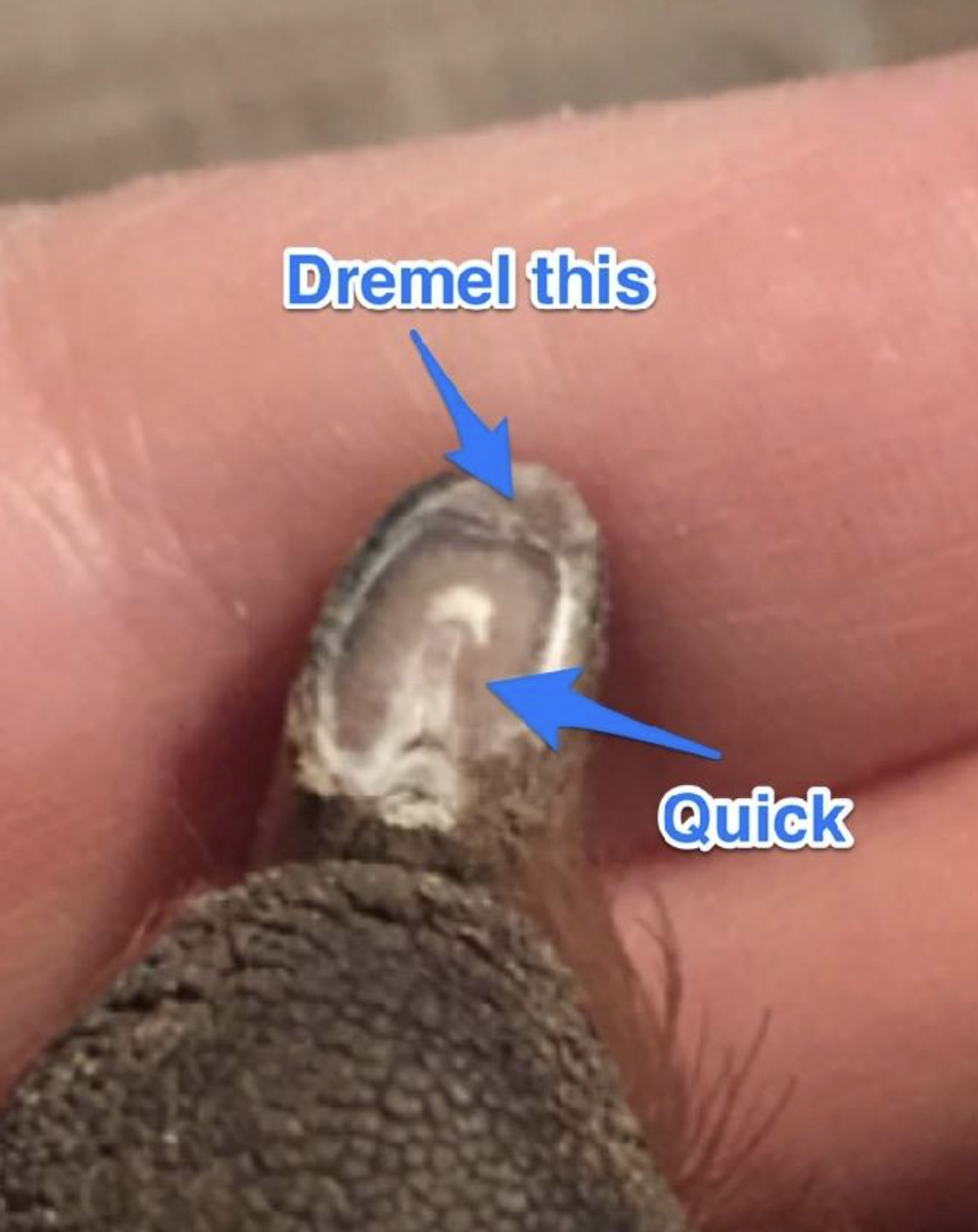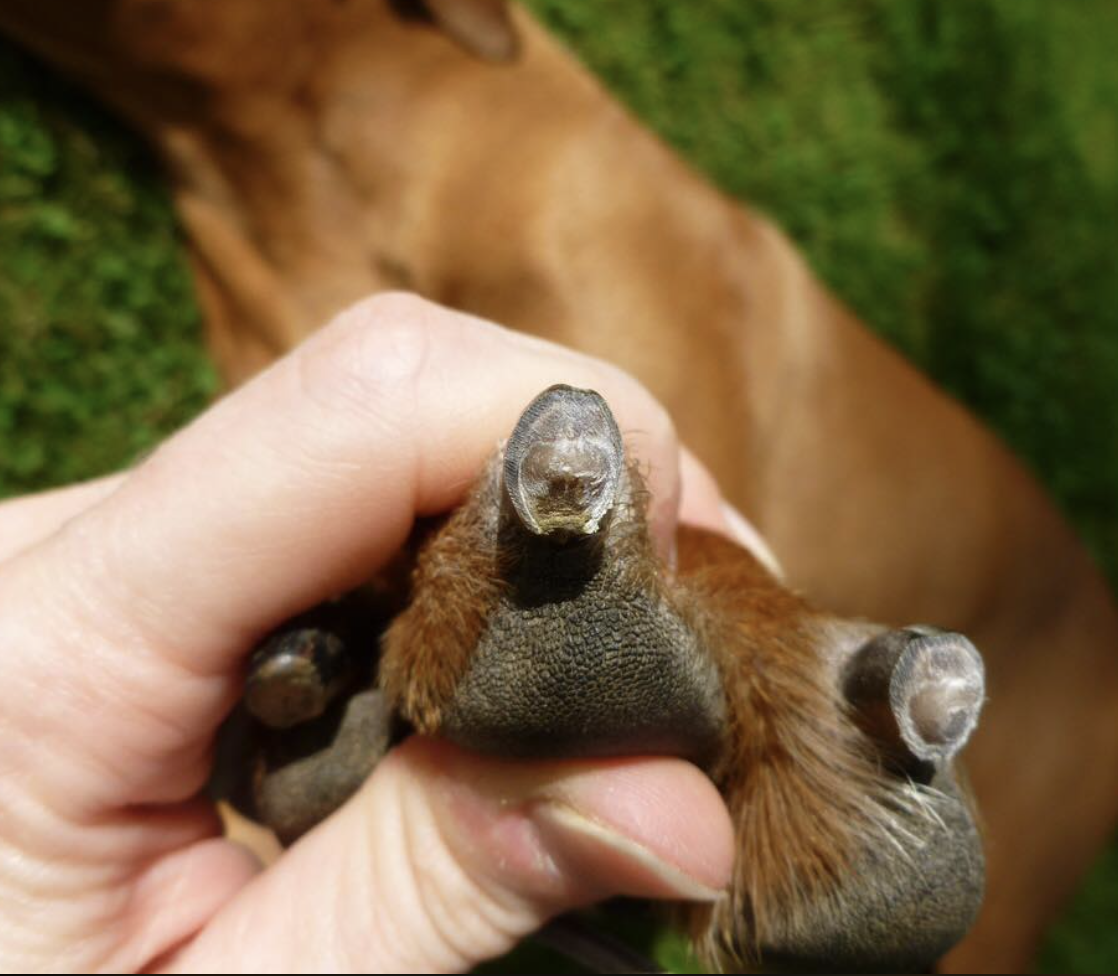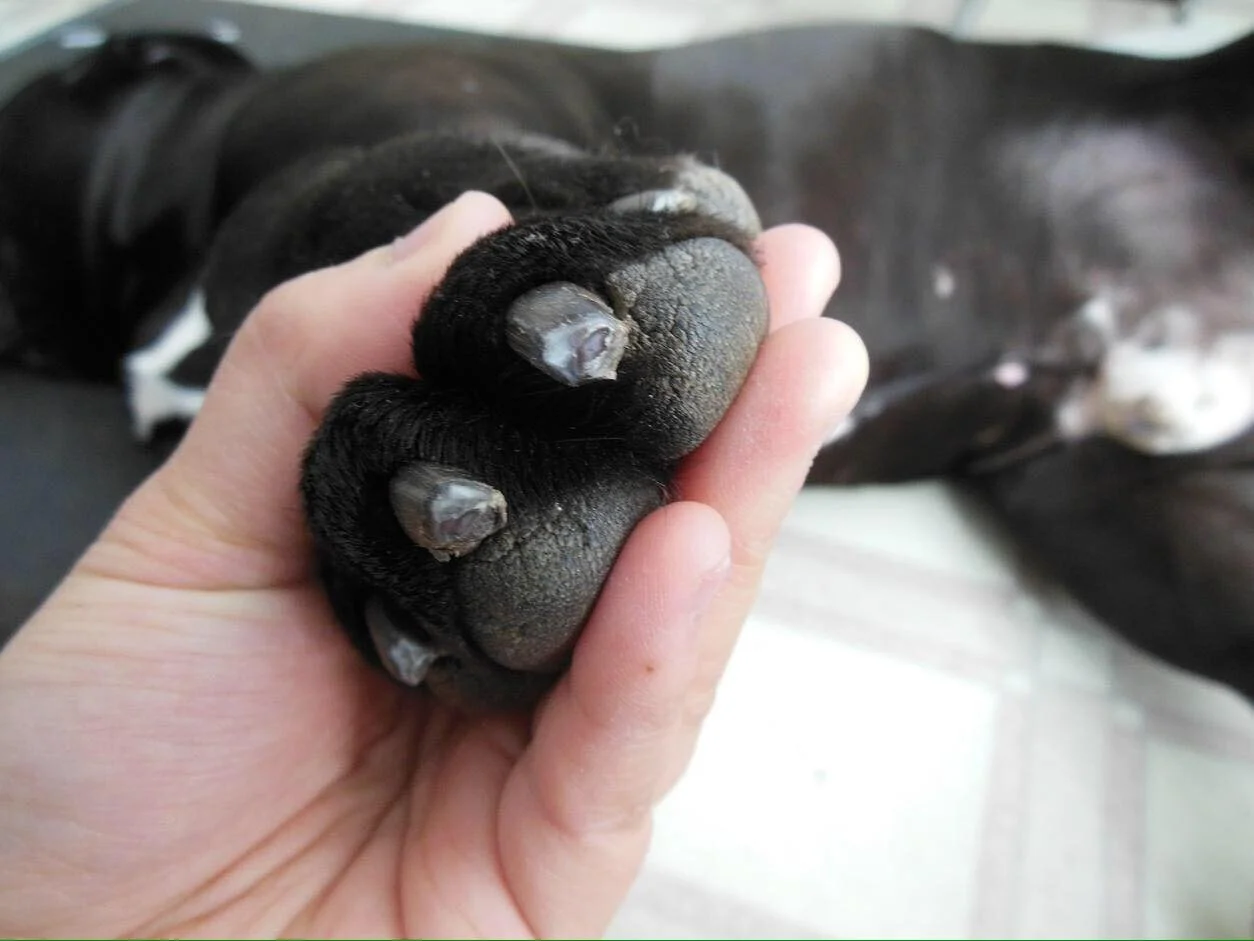Is cutting your dog's long nails giving you grief?
Nobody likes trimming dogs’ nails. But for the health and comfort of your dog, it must be done.
Long nails can cause much discomfort. It affects your dog’s posture and movement. They will not be able to balance, walk and run comfortably with long nails. Long nails are also a hazard because they can get caught and torn.
Trimming your dog’s nails should form part of your dog’s regular grooming and health procedure.
The change is immediate in the shape of this dog’s paws after a nail trim. He is now able to balance and walk properly on his paw pads.
Here are 15 FAQs and tips on how to make nail cutting a more pleasant experience for you and your dog.
1. Help! My dog will not let me trim his nails.
Time and patience will help your dog feel confident and comfortable about nail trimming. This is not something that will happen overnight. Break the process down into smaller components and desensitise your dog to each component before moving to the next one.
Firstly, analyse which component your dog doesn’t like. Does he hate his paw held? Does he hate his nail touched? Does he hate the ‘clicking’ sound made by the clippers cutting nail?
Secondly, once you have isolated which component makes your dog anxious, you can condition your dog to enjoy (or at least tolerate) nail trims.
The videos below are helpful for desensitisation.
Kikopup Channel (one of my favourite YouTube channels!)
https://www.youtube.com/watch?v=LHgBvnQ71ss
Freeport vet
https://www.facebook.com/Freeportvet/videos/234769727198213/
Don’t push your dog or ask him for more than what he is capable of facing at that moment. Any yelping or crying are grounds for stopping. If he or she is not capable of giving more, it is because you have not prepared him for this. Work on your dog daily in short sessions. Set your dog up for success and ensure you end each session on a high.
2. Why do I need to trim my dog’s nails? Walking keeps his nails short.
Walking alone may not be enough to keep your dog’s nails at the perfect length. It takes time walking on a variety of abrasive surfaces to wear down a dog's nails. Also walking only takes off the bottom bit of the nail.
Yes, it is true that when dogs spend a good deal of time outdoors running on various hard surfaces, their nails are worn down. But today, many urban dogs are increasingly confined indoors and running mostly on soft surfaces such as grass when outdoors.
3. Why do dogs need their nails trimmed short
This is not just an aesthetic issue, it is also a functional one. Long nails compromise your dog’s weight distribution, balance and natural alignment. It can make walking and running difficult and painful. Nail maintenance is especially important in arthritic senior dogs because long nails can exacerbate issues. It can throw a dog off-balance, causing unnecessary strain.
When long nails touch hard ground, the hard surface pushes the nail back into the nail bed creating pain. This puts pressure on the toe joints and may force the toe to twist to one side. Long term, this can realign the joints of the foreleg and make the foot look flattened and splayed.
4. What is the right nail length?
When a dog is standing, the nails should not touch the ground. If you can hear your dog coming from the ‘clicking’ on hard flooring, his nails are too long.
Nails should not touch the ground when a dog is standing.
5. What are your tips for clipping nails?
Use only very sharp nail clippers and cut off little bits rather than one big chunk at a time. Use ONLY very sharp clippers. The clippers should cut the nail like a knife through butter. Dull clippers will crush the nail and cause pain, even if you are not in the quick. Throw your old clippers away and buy new ones regularly.
6. I tried to trim my dog’s nails but I made him bleed.
One of the scariest parts of cutting dogs’ nails is the possibility of cutting the quick, the blood vessel inside the dog’s nail. Nicking the quick is painful for the dog and there is usually heaps of bleeding. You can get nails shorter by following these ‘alternative cut’ lines:
Avoid the red area (the quick). Focus on cutting the top (the roof of the nail) and sides. Not the bottoms where there is a greater chance of clipping the quick. Aim to cut at 45 and 90 degree angles. The 45 degree cut takes length off; the 90 degree cut helps the quicks recede. You can use clippers to take length off. I recommend a nail grinder or nail file for the vertical 90 degree cut to get as close to the quick as possible to encourage it to recede.
Learn to read your dog’s nails and check the section of the nail frequently as you trim or grind. For black nails, stop cutting or grinding once you see the gray or ‘whitish’ oval centre poking through (read no. 8 for more detailed explanation). For white nails, stop when you see the pink centres in cross-section.
7. How do I stop the bleeding?
Buy styptic powder such as Kwik-Stop to promote clotting. I have found this to be the best and fastest way to stop the oozing blood. If you don’t have any, cornstarch and bicarbonate soda works too (but not as fast as styptic powder). You need to press the stuff into the bleeding nail. It won’t work if you just sprinkle it on. Apply with cotton bud, hold onto nail for 30 seconds or until bleeding stops. Reapply powder if the cut is deep and the bleeding continues.
8. My dog has black nails. I am afraid of nicking the quick.
Black nails can be a challenge. In a light nail, the quick is visible from the side. But the quick in a black nail is invisible. With these nails, you have to be conservative and trim a little at a time. After making each cut, look at the cross-section of the nail. If you see a lightish oval spot in the center, stop cutting. It’s likely your next slice will hit the quick. If you are using a grinder, feel for a change in the density of the nail. When you are near the quick, the nail feels softer and the grinder will be quieter - this is when you stop. The video below shows how to trim a black nail:
https://vimeo.com/118336270?fbclid=IwAR1zXwtRtgK17PZl3LAQv7Ra1JhKyIOzNEx4pwqhz30BvivvJsSexYFNnkU
Area surrounding the quick is soft and usually light in colour, even in a black nail. You need to expose this layer to train the quicks to recede.
This is usually as short as I am comfortable exposing.
The quick is in the centre of the nail. The area that surrounds the quick is soft like jelly. It is usually grayish. Exposing this layer will train the quick to recede. Don’t dremel beyond this. If you dremel further, you will see a pin prick of blood in the centre. If you are still unsure you have reached the soft centre, gently push a finger nail into this layer to ensure it’s soft; or you can do it by the sound of the dremel (when the layers change, the dremel will sound softer)
Do not dremel beyond the soft nail centre. If you dremel further, you will see blood.
Soft nail centre has been exposed. The trick to training quicks to recede is to expose this centre without making the nail bleed.
When the soft center has been exposed, restrict exercise on hard ground for a few days because walking on abrasive surfaces can lead to exposure of the quick. This is not recommended because it could be painful for your dog and opens the nail to infection.
9. My dog has long quicks. How do I train the quicks to recede?
If cutting even small bits of nail makes your dog bleed, your goal would be to grind down the nails to get as close as possible to the quick. The easiest way to accomplish this is with a grinding tool (such as a Dremel). The quick will begin to recede within days. Continue grinding the nail regularly every 2-3 days until the quick recedes to an acceptable length. Be patient. If your dog’s feet have been neglected for months or years, it might take months to shorten those nails to a healthy length.
10. What tools do you recommend for trimming nails?
Sharp nail clippers (My favourite clippers are by Millers Forge)***
Dremel (preferably cordless)
Styptic powder
Treats - Essential in your nail kit! Now is the time to lavish your dog with praise
Dremel Micro with Diamagroove attachment
Millers Forge nail clipper
Don’t be fooled by the ‘Not recommended for large breeds’ wording on the Millers Forge packaging. My recommendation is to cut little bits of nail off, rather than a huge chunk, at a time. I have found these clippers perfect for that task.
But my personal tool preference for shortening nails is with a grinder, such as Dremel, rather than nail clippers. A grinder acts like a nail file and slowly grinds the nail to the desired length. If you are new to nail grinders, please read tip no. 15 on how to use a grinder safely.
11. How often should I cut my dog’s nails to maintain it?
Once a week is ideal if you want to gradually shorten your dog’s nails and eliminate all that clicky-clacking on your floors. If your dog’s nails are at a healthy length, twice a month is a reasonable goal to maintain the nails.
If your dog’s nails are overgrown, and the quicks are very long, you will need to trim or grind every few days to recede the quicks.
Make nail maintenance a routine part of your dog’s health care regime. It will be far easier for you to maintain short nails than to shorten nails that have become too long.
12. When is the best time to cut my dog’s nails?
Dog nails are soft when they are wet. So a good time to trim your dog’s nails is after a bath. This also dampens the clipping sound of nail clippers that freaks some dogs out.
Note: This may not be a good time if your dog is anxious after a bath - only cut nails when your dog is calm and happy.
13. What is the trick to getting the quicks to recede?
The trick to getting quicks to recede is to get as close to the quick as possible without nicking it. Focus on the cutting angles (diagram at tip no. 6). Each time you cut or dremel the nail, the quick will recede shorter and shorter. Be patient. This will take time.
14. I am ‘training’ the nail quicks to recede. How much can I safely and comfortably take off?
Learn to read your dog’s nails. If you go too short, it can cause your dog pain and discomfort when walking.
Do NOT focus on the underside/bottom of the nail where the nerves are concentrated. This will expose the the soft centre part of the nail that is around the quick. You don’t want to see this area poking through. When your dog is walking this soft centre will rub on the ground, exposing the quick and making him bleed. Focus instead on the sides and top of the nail.
15. I want to buy a Dremel. Any tips for using it?
Firstly, you will have a choice of corded or cordless models. Personally, I prefer cordless.
Secondly, familiarise yourself with the different grades of sanding bands. A sanding band with a rough grit like 60 will shorten the nail. The higher the grit, the smoother the band and thus the smoother the nail. So for eg a 120 grit band can be used to smooth out the nail.
Instead of sanding bands, I use a diamagroove attachment on my dremel micro. Unlike traditional dremel attachments that heats up quickly, the diamagroove stays cool.
*** Update 2023. Due to quality control issues, I no longer recommend these clippers. Read all about my new favourite nail clippers here.
Credit reference:
https://www.facebook.com/groups/nail.maintenance.for.dogs
Flaim, D. 2016 ‘The Importance of Trimming Dog Nails,’ Whole Dog Journal’ https://www.whole-dog-journal.com/care/nail-clipping/the-importance-of-clipping-dogs-nails/










